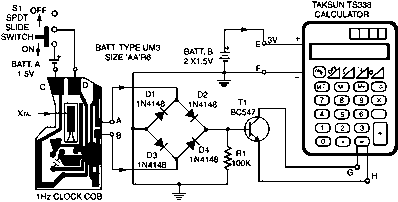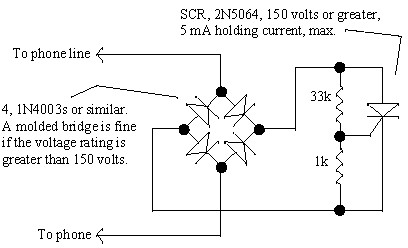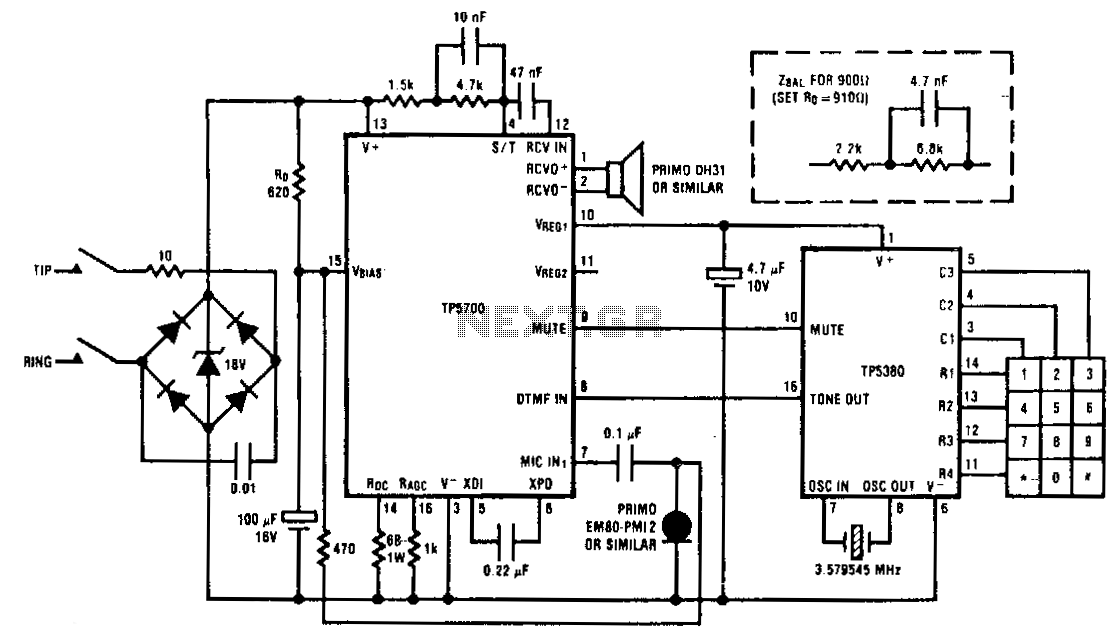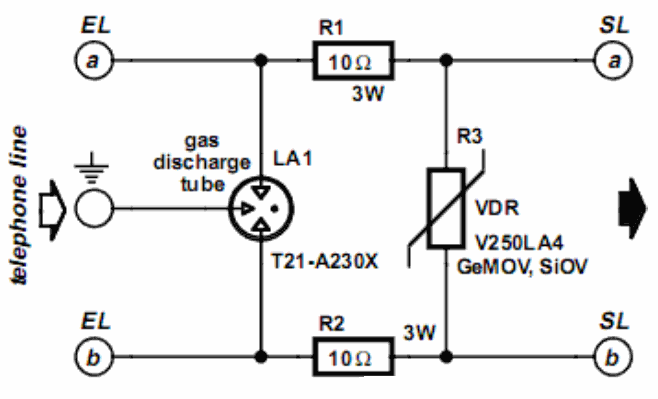
Phone Call answering machine (PIC16F870)
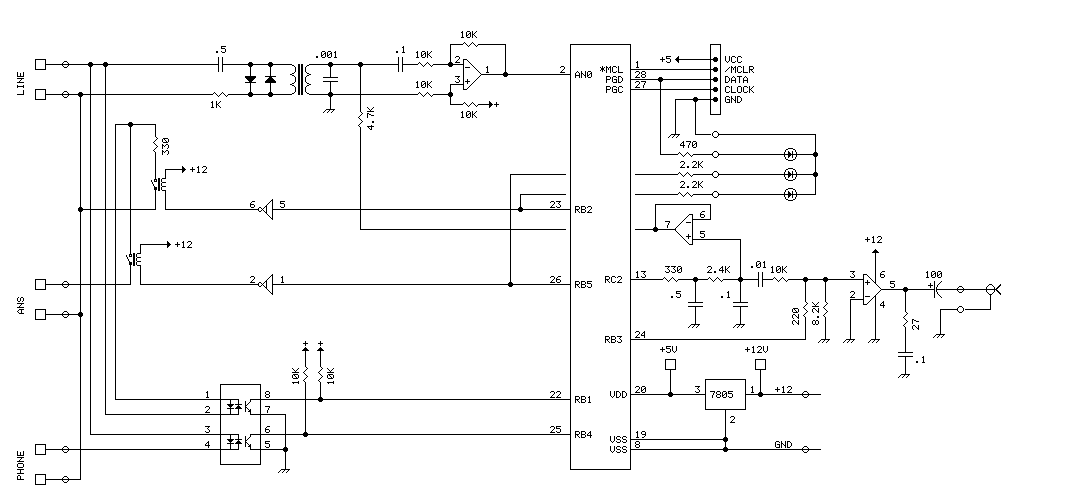
The PIC16F870 chosen for this project has several analog channels. One of these is used to capture the DTMF tones and decode the digits. The actual phone connections are made using a 'hacked' 5 line expander from Radio Shack. This device connects between the phone line, an answering machine, and your phones. When a phone call comes in, the answering machine picks up the call and informs the caller to enter the access code to ring the phone or to wait for the beep and leave a message. If the correct code is entered, the answering machine is immediately disconnected while the device generates phone ringing tones on an external speaker. Picking up any phone causes the device to return to its initial state. The design of this device is greatly simplified by having the answering machine 'do the talking' and using a speaker as a ringer rather than actually generating a ring signal (90 volts) to actually ring the phones. The list of functions left to the device itself are as follows: Decode the DTMF frequencies from the phone line. Detect the answering machine picking up the line. Detect the local phone being picked up or hung up. Detect the calling party hanging up. Generate a ring signal for the speaker. Check to see if my bedroom door is closed. Inside the casing, separate connections were made to each of the connectors and run out through the back of the case. Since I live in a rather large house (with 5 other people at this time), I used a PA horn for the ringer/speaker. As a compromise to local sanity, the level of the ringer is reduced when I am sleeping or not at home. The 'door sense' input detects the 'state' of my bedroom door since that is where the speaker is located.
The project utilizes the PIC16F870 microcontroller, which is equipped with several analog input channels, allowing it to interface directly with incoming DTMF (Dual-Tone Multi-Frequency) signals from the phone line. The core functionality of the device revolves around the decoding of these DTMF tones, which enables the identification of digits pressed by the caller. The device is designed to work in conjunction with an answering machine, which serves as the primary interface for the caller.
When a call is received, the answering machine answers the line and instructs the caller to enter an access code. Upon successful entry of this code, the answering machine disconnects, and the PIC16F870 activates an external speaker to generate ringing tones, simulating the ringing of a traditional phone. This approach eliminates the need to generate high-voltage ringing signals, simplifying the design and reducing potential hazards.
The circuit includes several critical detection functions. It monitors the phone line to detect when the answering machine picks up, when the local phone is picked up or hung up, and when the calling party disconnects. This allows the device to return to its initial state promptly after a phone call is completed.
Additionally, the design incorporates a monitoring feature for the bedroom door, which is essential for controlling the volume of the ringer. A PA horn is employed as the ringer, providing sufficient sound output for a large house. To accommodate various living situations, the volume level of the ringer can be adjusted based on the state of the bedroom door, ensuring that it is not overly disruptive during sleep or when the user is not at home.
The internal circuitry is organized with separate connections for each of the phone line interfaces, which are routed out through the back of the casing for easy access and maintenance. This modular design enhances the overall usability and adaptability of the system, making it suitable for a shared living environment.The PIC16F870 chosen for this project has seval analog channels. One of these is used to capture the DTMF tones and decode the digits. The actual phone connections are made using a 'hacked' 5 line expandor from Radio Shack. This device connects between the phone line, an answering machine, and your phones. When a phone call comes in, the answering machine picks up the call and informs the caller to enter the access code to ring the phone or to wait for the beep and leave a message. If the correct code is entered, the answering machine is immediately disconnected while the device generates phone ringing tones on an external speaker.
Picking up any phone causes the device to return to its initial state. The design of this device is greatly simplified by haveing the answering machine 'do the talking' and using a speaker as a ringer rather than actually generating a ring signal (90 volts) to actually ring the phones. The list of functions left to the device itself are as follows..... Decode the DTMF frequencies from the phone line. Detect the answering machine picking up the line. Detect the local phone being picked up or hung up. Detect the calling party haning up. Generate a ring signal for the speaker. Check to see if my bedroom door is closed. Inside the casing, seperate connections were made to each of the connectors and run out thru the back of the case.
Since I live in a rather large house (with 5 other people at this time), I used a PA horn for the ringer/speaker. As a compromise to local sanity, the level of the ringer is reduced when I am sleeping or not at home.
The 'door sense' input detects the 'state' of my bedroom door since that is where the speaker is located. 🔗 External reference
The project utilizes the PIC16F870 microcontroller, which is equipped with several analog input channels, allowing it to interface directly with incoming DTMF (Dual-Tone Multi-Frequency) signals from the phone line. The core functionality of the device revolves around the decoding of these DTMF tones, which enables the identification of digits pressed by the caller. The device is designed to work in conjunction with an answering machine, which serves as the primary interface for the caller.
When a call is received, the answering machine answers the line and instructs the caller to enter an access code. Upon successful entry of this code, the answering machine disconnects, and the PIC16F870 activates an external speaker to generate ringing tones, simulating the ringing of a traditional phone. This approach eliminates the need to generate high-voltage ringing signals, simplifying the design and reducing potential hazards.
The circuit includes several critical detection functions. It monitors the phone line to detect when the answering machine picks up, when the local phone is picked up or hung up, and when the calling party disconnects. This allows the device to return to its initial state promptly after a phone call is completed.
Additionally, the design incorporates a monitoring feature for the bedroom door, which is essential for controlling the volume of the ringer. A PA horn is employed as the ringer, providing sufficient sound output for a large house. To accommodate various living situations, the volume level of the ringer can be adjusted based on the state of the bedroom door, ensuring that it is not overly disruptive during sleep or when the user is not at home.
The internal circuitry is organized with separate connections for each of the phone line interfaces, which are routed out through the back of the casing for easy access and maintenance. This modular design enhances the overall usability and adaptability of the system, making it suitable for a shared living environment.The PIC16F870 chosen for this project has seval analog channels. One of these is used to capture the DTMF tones and decode the digits. The actual phone connections are made using a 'hacked' 5 line expandor from Radio Shack. This device connects between the phone line, an answering machine, and your phones. When a phone call comes in, the answering machine picks up the call and informs the caller to enter the access code to ring the phone or to wait for the beep and leave a message. If the correct code is entered, the answering machine is immediately disconnected while the device generates phone ringing tones on an external speaker.
Picking up any phone causes the device to return to its initial state. The design of this device is greatly simplified by haveing the answering machine 'do the talking' and using a speaker as a ringer rather than actually generating a ring signal (90 volts) to actually ring the phones. The list of functions left to the device itself are as follows..... Decode the DTMF frequencies from the phone line. Detect the answering machine picking up the line. Detect the local phone being picked up or hung up. Detect the calling party haning up. Generate a ring signal for the speaker. Check to see if my bedroom door is closed. Inside the casing, seperate connections were made to each of the connectors and run out thru the back of the case.
Since I live in a rather large house (with 5 other people at this time), I used a PA horn for the ringer/speaker. As a compromise to local sanity, the level of the ringer is reduced when I am sleeping or not at home.
The 'door sense' input detects the 'state' of my bedroom door since that is where the speaker is located. 🔗 External reference
